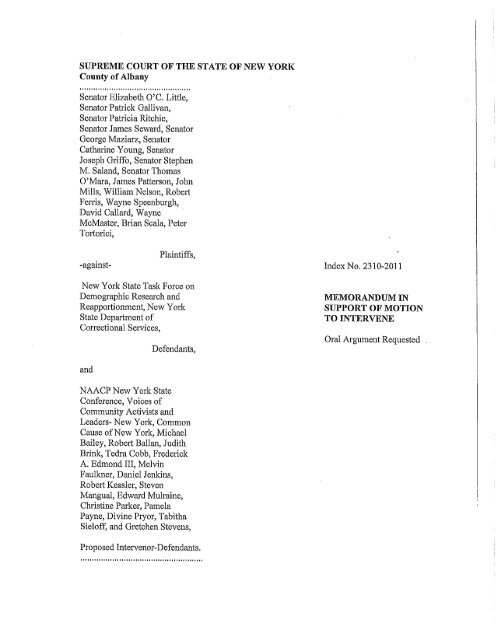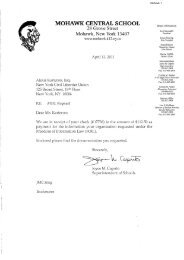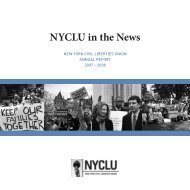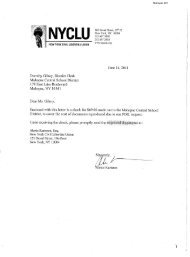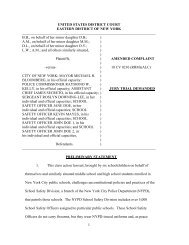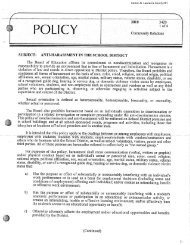Memo in Support of Motion to Intervene (PDF) - New York Civil ...
Memo in Support of Motion to Intervene (PDF) - New York Civil ...
Memo in Support of Motion to Intervene (PDF) - New York Civil ...
You also want an ePaper? Increase the reach of your titles
YUMPU automatically turns print PDFs into web optimized ePapers that Google loves.
SUPREME COURT OF THE STATE OF NEW YORK<br />
County <strong>of</strong> Albany<br />
Sena<strong>to</strong>r Elizabeth O'C. Little,<br />
Sena<strong>to</strong>r Patrick Gallivan,<br />
Sena<strong>to</strong>r Patricia Ritchie,<br />
Sena<strong>to</strong>r James Seward, Sena<strong>to</strong>r<br />
George Maziarz, Sena<strong>to</strong>r<br />
Cathar<strong>in</strong>e Young, Sena<strong>to</strong>r<br />
Joseph Griffo, Sena<strong>to</strong>r Stephen<br />
M. Saland, Sena<strong>to</strong>r Thomas<br />
O'Mara, James Patterson, John<br />
Mills, Willirun Nelson, Robeli<br />
Ferris, Wayne Speenburgh,<br />
David Callard, Wayne<br />
McMaster, Brian Scala, Peter<br />
Tor<strong>to</strong>rici,<br />
Pla<strong>in</strong>tiffs,<br />
"aga<strong>in</strong>st" Index No. 2310"2011<br />
<strong>New</strong> <strong>York</strong> State Task Force 011<br />
Demographic Research and<br />
Reapportionment, <strong>New</strong> <strong>York</strong><br />
State Department <strong>of</strong><br />
Correctional Services,<br />
Defendants,<br />
MEMORANDUM IN<br />
SUPPORT OF MOTION<br />
TO INTERVENE<br />
Oral Argument Requested<br />
and<br />
NAACP <strong>New</strong> <strong>York</strong> State<br />
Conference, Voices <strong>of</strong><br />
Community Activists and<br />
Leaders" <strong>New</strong> <strong>York</strong>, Common<br />
Cause <strong>of</strong> <strong>New</strong> <strong>York</strong>, Michael<br />
Bailey, Robert BalIan, Judith<br />
Br<strong>in</strong>k, Tedra Cobb, Frederick<br />
A. Edmond III, Melv<strong>in</strong><br />
Faulkner, Daniel Jenk<strong>in</strong>s,<br />
Robert Kessler, Steven<br />
Mangual, Edward Mulra<strong>in</strong>e,<br />
Christ<strong>in</strong>e Parker, Pamela<br />
Payne, Div<strong>in</strong>e Pryor, Tabitha<br />
Siel<strong>of</strong>f, and Gretchen Stevens,<br />
Proposed Intervenor- Defendants.
Table <strong>of</strong> Contents<br />
Page<br />
<strong>Memo</strong>randum <strong>of</strong> Law In <strong>Support</strong> <strong>of</strong> Proposed Intervenor Defendants <strong>Motion</strong> <strong>to</strong><br />
Interven e """ , , 1<br />
Prelim<strong>in</strong>a Statement " ", ".'1<br />
Il. Proposed Intervenors .tI 11"'1 't'"I' t", I tI I t, tt, 'II"" tI III f'" "'It tI' t II t, tt tI ""'" If' I ,_". tt '11" tt t •• ",."" <strong>to</strong> 6<br />
Ill, Interests <strong>of</strong> Proposed Intervenors <strong>in</strong> this Lawsuit " ..,7<br />
J. This Court Should Grant Intervention as <strong>of</strong> Right " """" " " ..""."",,9<br />
II. This Court Should GrantIntervention as <strong>of</strong>'Right., ".""".""""""." .."."""" ..".",,9<br />
A. Proposed Intervenors Acted <strong>in</strong> a Timely Mal1l1er""""".""""""." " 10<br />
B. Defendants Will Not Adequately Represent the Interests <strong>of</strong> Proposed Intervenors<br />
•• "I ••• '.', ••• ' •• ,I ••• "', •• , •••• ,,".".,"."."" •• ,"'.'-II."' •• "'.,I'.,"I ••• "'", •••• , •• , •• " •• , •• """'",'1""",.,, •• 10<br />
C. Proposed Intervenors Will Be Bound by the Judgment " 16<br />
III. The Court Should Also Grant Permissive Intervention ..18<br />
Conclusion "..""".".""" ".".."" ""., .."., " ,,, "..,,20
Table <strong>of</strong> Authorities<br />
Page(s)<br />
Cases<br />
Bay State Heat<strong>in</strong>g & Air Condition<strong>in</strong>g Co. v American Ins. Co., 78 AD2d 147, 149 [4th<br />
Dept 1980] "" I t tt " •••• It Ol """ ",. I" I' tt. " t It ••• " ••••••••••••• ", It' '" " "" '" '" '" "'l It.", ""'" tI" , •• , ",18<br />
Berkoski v Board <strong>of</strong> Trustees<br />
II" ,.,1<br />
<strong>of</strong> Inc. Vil. <strong>of</strong> Southamp<strong>to</strong>n, 67 AD3d 840, 843 [2d Dept<br />
2009] ., ,.'t'I'IIII"" ,.,'""""·,, .••.. ' .••• ',I.,.,.,"I " ..• "" ". """'" .•.• " ,••••.•••. , ••.••.••.. ".,.""".16<br />
<strong>Civil</strong> Service Bar Assoc., etc. v <strong>New</strong> <strong>York</strong>, 64 AD2d 594, 595 [1st Dept 1978] 12<br />
County <strong>of</strong> Westchester v Department <strong>of</strong> Health, 229 AD2d 460, 461 [2d Dept 1996] 16<br />
Dal<strong>to</strong>n v Pataki, 5 NY3d 243, 277 78 [Ct App 2005] w 16<br />
Herdman v Town <strong>of</strong> Angelica, 163 FRD 180, 189 9l w fWD NY 1995] 13<br />
In re Waxman, 96 AD2d 908, 908 [2d Dept 1983] 12<br />
Jeffer v Jeffer, 28 Mise 3d l238A [Sup Ct, K<strong>in</strong>gs County 2010] 10<br />
Kaczmarek v Sh<strong>of</strong>fstall, 119 AD2d 1001, 1002 [4th Dept 1986] 17<br />
Lenihan v Blackwell, 209 AD2d 1048, 1049 [4th Dept 1994] 11<br />
Little v <strong>New</strong> <strong>York</strong> State Task Force on Demographic Research and Reapportionment,<br />
et. al., <strong>in</strong>dex No. 2310..2011, tt """," " I •• "".i, , •• " ••• If tI. t. Ol ,."., """"'" ."., •••• ,.,., , •• ,<br />
Matter <strong>of</strong> Romeo v <strong>New</strong> <strong>York</strong> State Dept. <strong>of</strong>Educ.,<br />
" ."",<br />
39 AD3d 916,917<br />
""" ".1<br />
[3d Dept 2007] .. 10<br />
McCall v Hynes, 196 AD2d 618, 6l8w619 [2d Dept 1993] 11<br />
Mcûermott v Mcûermott, 119 AD2d 370,374 [2d Dept 1986] 19<br />
N. Y. Pub. Interest Research Group, Inc. v Regents <strong>of</strong> the Univ. <strong>of</strong> the State <strong>of</strong> N. Y., 516<br />
F2d 350, 352 [2d Cil' 1975] 13<br />
Oleska v D 'Apice, 123 AD2d 302 [Zd Dept 1986] 11<br />
Grans v Rockefeller, 47 Mise2d 493, 497 [Sup Ct, <strong>New</strong> <strong>York</strong> County 1965] 11, 12<br />
Patterson Materials Corp. v Town <strong>of</strong> Paw l<strong>in</strong>g, 221 AD2d 609,610 [2d Dept 1995] 19<br />
Perl v Aspromonte Realty Corp., 143 AD2d 824, 825 [2d Dept 1988] 16<br />
Plantech Hous<strong>in</strong>g) Inc. v Conlan, 74 AD2d 920, 921 [2d Dept 1980] 20<br />
Prometheus Realty v City <strong>of</strong> <strong>New</strong> <strong>York</strong>, 2009 NY Slip Op 30273[U], *4~5 [Sup Ct, <strong>New</strong><br />
Yor!< County 2009] """ ,. I •••••••<br />
Ramos v Alpert, 41 AD2d 1012 [3d Dept 1973] 11<br />
Sieger v Sieger, 297 AD2d 33, 36 [2d Dept 2002] 16<br />
State ex rel. Field v. Cranshaw, 139 Mise 2d 470,472 [Sup Ct, Nassau County 1988] 12<br />
Subdivisions, Inc. v Town <strong>of</strong>Sullivan, 75 AD3d 978, 979 80 [3d Dept 2010] w 12<br />
Teleprompter Manhattan CATV Corp. v State Board <strong>of</strong> Equalization & Assessment, 34<br />
. AD2d 1033 [3d Dept 1970] .,."." -., ,." ' "'.I ••••••••• """"""""""1""""""",, ••• 9<br />
Town <strong>of</strong> Southold v Cross Sound Ferry Servs. , 256 AD2d 403, 404 [2d Dept 1998] 18<br />
Trbovich v United M<strong>in</strong>e Workers <strong>of</strong> America, 404 U.S. 528, 538 note 10 [1972] 12<br />
Vantage Petroleum v Board <strong>of</strong> Assessment Review, 61 NY2d 695, 698 [Ct App 1984] .. 17<br />
Vantage Petroleum v Board <strong>of</strong> Assessment Review, 91 AD2d 1037, 1040 [2d Dept<br />
1983], . , . , , . , 1 • " •• , • , •• , • t • I , • I t ••• , t , I ••••• • I • I , • , , ••• , •• , , , •••• , , , •• , , , , I • I I "1 , , I , I I • , ••••• ,. 12<br />
Yuppie Puppy Pet Prods. v Street Smart Realty, LLC, 77 AD3d 197,201 [1st Dept 2010]<br />
".f ••• ,t. ,." ." •••• , ••• ,., ••• , """"",."t.""".,,, •.• ""' ••. "", ••••••• ,."".,.,." """"""f""" ""'t. 10, 11., 16, 17<br />
Constitutions<br />
N,Y. Const. Art II, § 4,., "'1""'" II" ••• ""'" " •••••• , t,. , ••• "".f",, t I" ." "" I" .,1 ._., ,., •• ,,2<br />
Other Authorities<br />
u
<strong>New</strong> <strong>York</strong> State Department <strong>of</strong> Correctional Services, HUB SYSTEM: Prame <strong>of</strong> Inmate<br />
Population Under Cus<strong>to</strong>dy on January 1, 2008, at ii, available at<br />
http://www.docs.state.ny.us/ResearchlReports/2008/Hub _Report; 2008. pdf [accessed<br />
May 12, 2011J"IIII'III""""""II"""""""'I'I"'I'"I,I'""""""I"""""""""""",."."."., ..• ", ••• ,.,.5<br />
Prison Policy Initiative, <strong>New</strong> Senate Districts, April22, 2002, at figure 10,<br />
http://www.prisonpolicy.org/import<strong>in</strong>g/flg10.html [accessed May 12,2011].) 5<br />
Vielk<strong>in</strong>d, L<strong>in</strong>e Drawn on Prison Head Count Debate, Albany Times Union, Jan. 31,<br />
2011, section A, at 1 _ 14<br />
Rules<br />
CPLR 1012 1, 10, 11, 12, 16, 18,20<br />
CPLR 1013'... tf' ., •• I"""" t ••••• , •••••• """ "" I" •• , ••• , "'" I" tt. t I t , •• ""t' '" '" I •••• , .• ,. I tI I •• ,. " , •• ',. It., 1, 1,8, 20 .<br />
Treatises<br />
We<strong>in</strong>ste<strong>in</strong>, Korn and Miller, CPLR Manual § 1012.05 " 9<br />
We<strong>in</strong>ste<strong>in</strong>, Korn and Miller, <strong>New</strong> <strong>York</strong> <strong>Civil</strong> Practice § 1012.Œ 12<br />
Wright, Miller and Kane, Federal Practice and Procedure: <strong>Civil</strong> § 1908.1 {3d ed rev<br />
2010) I I t " It tt t I I It" t tt I" """,", I .'. I., f. "'"' o, , •• '0" ., •••••• 111"'1 ,t "" tI" I t II I,.t •• ,.I"".t •• ,. I I I 1 II •••••. " t '1"'" 1.13<br />
iii
MEMORANDUM OF LAW IN SUPPORT OF<br />
PROPOSED .INTERVENOR DEFENDANTS' MOTION TO INTERVENE<br />
Pursuant <strong>to</strong> rule 1012 (a) (2) <strong>of</strong> the <strong>Civil</strong> Practice Laws and Rules, NAACP <strong>New</strong><br />
<strong>York</strong> State Conference ("NAACP"), Voices <strong>of</strong> Community Activists and Leaders<br />
("VOCAL"), Common Cause <strong>of</strong> <strong>New</strong> <strong>York</strong>, ("Common Cause") ("organizational<br />
<strong>in</strong>tervenors"), and Michael Bailey, Robert Ballan, Judith Br<strong>in</strong>k, Tedra Cobb, Frederick A.<br />
Edmond III, Melv<strong>in</strong> Faulkner, Daniel Jenk<strong>in</strong>s, Robert Kessler, Steven Mangual, Edward<br />
Mulra<strong>in</strong>e, Christ<strong>in</strong>e Parker, Pamela Payne, Div<strong>in</strong>e Pryor, Tabitha Siel<strong>of</strong>f, and Gretchen<br />
Stevens ("<strong>in</strong>dividual <strong>in</strong>tervenors") (collectively, "proposed <strong>in</strong>tervenors"), move <strong>to</strong><br />
<strong>in</strong>tervene as <strong>of</strong> right <strong>in</strong> this action and, <strong>in</strong> the alternative, permissively <strong>in</strong>tervene pursuant<br />
<strong>to</strong> rule 1013 <strong>of</strong> the <strong>Civil</strong> Practice Laws and Rules.<br />
As set forth below, proposed<br />
<strong>in</strong>tervenors satisfy the requirements both for <strong>in</strong>tervention as <strong>of</strong> right and for permissive<br />
<strong>in</strong>tervention and respectfully request that they be permitted <strong>to</strong> <strong>in</strong>tervene as defendants <strong>in</strong><br />
the matter Little v <strong>New</strong> <strong>York</strong> State Task Force on Demographic Research and<br />
Reapportionment; et.al., <strong>in</strong>dex No. 2310-2011.<br />
Prelim<strong>in</strong>ary<br />
Statement<br />
Proposed <strong>in</strong>tervenors seek <strong>to</strong> defend the constitutionality <strong>of</strong> part XX ·<strong>of</strong> chapter 57<br />
<strong>of</strong> the Laws <strong>of</strong> 2010 ("part XX"), a recently-enacted <strong>New</strong> <strong>York</strong> law requir<strong>in</strong>g that<br />
<strong>in</strong>carcerated persons be allocated for state legislative redistrict<strong>in</strong>g purposes <strong>to</strong> their last<br />
address preced<strong>in</strong>g their <strong>in</strong>carceration, and for localities <strong>to</strong> exclude the prison population<br />
when conduct<strong>in</strong>g local redistrict<strong>in</strong>g.<br />
Part XX amends <strong>New</strong> <strong>York</strong>'s previous method,<br />
which allocated <strong>in</strong>carcerated persons <strong>to</strong> the districts where they were <strong>in</strong>carcerated dur<strong>in</strong>g<br />
redistrict<strong>in</strong>g, and thus Part XX makes the state's redistrict<strong>in</strong>g practice consistent with the
state constitutional def<strong>in</strong>ition <strong>of</strong> residence for <strong>in</strong>carcerated people: "no person shall be<br />
deemed <strong>to</strong> have ga<strong>in</strong>ed or lost a residence, by reason <strong>of</strong> his or her presence or absence ...<br />
while conf<strong>in</strong>ed <strong>in</strong> any public prison." N.Y. Canst. Art II, § 4.<br />
Part XX was specifically designed <strong>to</strong> remedy the <strong>in</strong>justice <strong>of</strong> the prior method <strong>of</strong><br />
apportionment, which arbitrarily and artificially enhanced the vot<strong>in</strong>g power <strong>of</strong> both state<br />
and county legislative<br />
districts <strong>in</strong> which the prisons were located and which lacked any<br />
<strong>in</strong>terest <strong>in</strong> common with the persons <strong>in</strong>carcerated. At the same time, the prior method<br />
unfairly diluted the vot<strong>in</strong>g power <strong>of</strong> <strong>in</strong>dividuals <strong>in</strong> all other districts. This dilution<br />
particularly affected voters liv<strong>in</strong>g <strong>in</strong> the largely African-American and Lat<strong>in</strong>o state<br />
legislative districts from which most members <strong>of</strong> the <strong>in</strong>carcerated population come and <strong>to</strong><br />
which they are likely <strong>to</strong> return, and voters liv<strong>in</strong>g <strong>in</strong> a county that conta<strong>in</strong>s<br />
a prison, but<br />
who live outside <strong>of</strong> the local election district conta<strong>in</strong><strong>in</strong>g the prison. If pla<strong>in</strong>tiffs prevail<br />
on their claims, these counties would be forced <strong>to</strong> treat <strong>in</strong>carcerated persons as ord<strong>in</strong>ary<br />
constituents,<br />
thus skew<strong>in</strong>g the balance <strong>of</strong> their local legislative districts. I<br />
The proposed <strong>in</strong>tervenors are voters and organizations that represent voters whose .<br />
vot<strong>in</strong>g rights would be diluted if the challenged statute were <strong>in</strong>validated. They <strong>in</strong>clude<br />
<strong>in</strong>dividual voters resid<strong>in</strong>g <strong>in</strong> urban downstate communities as well as upstate<br />
communities who would be harmed by assign<strong>in</strong>g the <strong>in</strong>carcerated population <strong>to</strong> prison<br />
districts for purposes <strong>of</strong> redistrict<strong>in</strong>g, <strong>to</strong>gether with several membership organizations<br />
that have an <strong>in</strong>terest <strong>in</strong> promot<strong>in</strong>g fail' representation and that have members whose rights<br />
are directly at stake <strong>in</strong> this litigation. Each <strong>of</strong> the proposed <strong>in</strong>tervenors seeks <strong>to</strong><br />
<strong>in</strong>tervene because the relief sought by pla<strong>in</strong>tiffs - an <strong>in</strong>junction restra<strong>in</strong><strong>in</strong>g enforcement<br />
I Prior <strong>to</strong> the passage <strong>of</strong> Part XX, counties were free <strong>to</strong> choose whether or not <strong>to</strong> count prisoners as<br />
residents <strong>of</strong> prisons for purposes <strong>of</strong> local redistrict<strong>in</strong>g. As noted below, 13 counties voluntarily chose <strong>to</strong><br />
remove the prison population before redistrict<strong>in</strong>g.<br />
2
<strong>of</strong> the statute and a declaration that the statute is unconstitutional -<br />
would deprive them<br />
<strong>of</strong> the very vot<strong>in</strong>g protections part XX was enacted <strong>to</strong> provide them.<br />
Named defendants -<br />
the Department <strong>of</strong> Correctional Services ("DOCS"), which<br />
is required under part XX <strong>to</strong> supply data on prisoners, and the <strong>New</strong> <strong>York</strong> Legislative<br />
Task Force on Demographic Research and Reapportionment ("LATFOR"), which uses<br />
the data for develop<strong>in</strong>g statewide redistrict<strong>in</strong>g plans -<br />
have no personal stake <strong>in</strong><br />
the vot<strong>in</strong>g rights protected by the statute and therefore no <strong>in</strong>stitutional <strong>in</strong>centive or<br />
<strong>in</strong>terest <strong>in</strong> protect<strong>in</strong>g those rights. Defendants are state agencies with m<strong>in</strong>isterial duties<br />
pursuant <strong>to</strong> part XX, and therefore, will not - <strong>in</strong>deed cannot be expected <strong>to</strong> -<br />
adequately represent the vot<strong>in</strong>g rights and <strong>in</strong>terests <strong>of</strong> proposed <strong>in</strong>tervenors which this<br />
lawsuit seeks <strong>to</strong> nullify.<br />
Proposed <strong>in</strong>tervenors' position is dist<strong>in</strong>ct. As <strong>in</strong>dividuals and membership<br />
organizations represent<strong>in</strong>g <strong>in</strong>dividuals whose votes were diluted under the previous<br />
method <strong>of</strong> count<strong>in</strong>g <strong>in</strong>carcerated <strong>in</strong>dividuals, proposed <strong>in</strong>tervenors <strong>in</strong>tend <strong>to</strong> argue not<br />
only that the State Constitution affords discretion <strong>to</strong> allocate <strong>in</strong>carcerated <strong>in</strong>dividuals <strong>to</strong><br />
their home addresses for redistrict<strong>in</strong>g purposes, but also that such an allocation is<br />
required by state and' federal equal protection requirements, and necessary <strong>to</strong> protect<br />
m<strong>in</strong>ority vot<strong>in</strong>g rights.<br />
Proposed <strong>in</strong>tervenors'<br />
concern that their vot<strong>in</strong>g rights will be <strong>in</strong>adequately<br />
represented by the present defendants is well-founded,<br />
At this time, defendant LATFOR<br />
has represented <strong>to</strong> the court that it does not <strong>in</strong>tend <strong>to</strong> make any formal submission.<br />
Instead, LATFOR has emphasized only their need for a prompt resolution <strong>of</strong> the case <strong>to</strong><br />
supply the certa<strong>in</strong>ty needed as <strong>to</strong> how <strong>to</strong> allocate <strong>in</strong>carcerated persons before they<br />
3
complete their task, rather than the need <strong>to</strong> defend the vot<strong>in</strong>g rights protected by Part Xx.<br />
Defendant DOCS, for its part, has asserted an affirmative defense that, if successful,<br />
would result <strong>in</strong> its dismissal from the case.<br />
Moreover, a f<strong>in</strong>al judgment <strong>in</strong>validat<strong>in</strong>g part XX would dispose <strong>of</strong> proposed<br />
<strong>in</strong>tervenors' vot<strong>in</strong>g rights that are now protected by the statute.<br />
Accord<strong>in</strong>gly, <strong>in</strong> every<br />
mean<strong>in</strong>gful sense, proposed <strong>in</strong>tervenors would be bound by that judgment.<br />
Under these<br />
circumstances and because this motion, made two bus<strong>in</strong>ess days after defendants'<br />
answer, is pla<strong>in</strong>ly timely, <strong>in</strong>tervention should be granted either as <strong>of</strong> right or<br />
permissively.<br />
Statement <strong>of</strong> Facts<br />
L<br />
Nature <strong>of</strong> the Case<br />
On August 3, 2010, the <strong>New</strong> <strong>York</strong> Legislature duly passed part XX <strong>of</strong> chapter 57<br />
<strong>of</strong> the Laws <strong>of</strong> 2010, legislation that required the state <strong>to</strong> allocate people <strong>in</strong>carcerated <strong>in</strong><br />
<strong>New</strong> <strong>York</strong> State prison facilities <strong>to</strong> their home communities for redistrict<strong>in</strong>g purposes.<br />
The Governor signed the legislation <strong>in</strong><strong>to</strong> law on August 12, 2010.<br />
The law was<br />
submitted <strong>to</strong> the United States Department <strong>of</strong> Justice for preclearance under section 5 <strong>of</strong><br />
the Vot<strong>in</strong>g Rights Act on March 8, 2011, and preclearance was granted on May 9, 2011. 2<br />
Prior <strong>to</strong> the enactment <strong>of</strong> part XX, <strong>New</strong> <strong>York</strong> allocated people <strong>in</strong>carcerated <strong>in</strong><br />
state prisons <strong>to</strong> the legislative districts where they were <strong>in</strong>carcerated, rather than <strong>to</strong> the<br />
home communities where they are legally domiciled, despite the fact that most people <strong>in</strong><br />
prison return <strong>to</strong> their home communities after release, and the median time that an<br />
2 If pla<strong>in</strong>tiffs prevail <strong>in</strong> this action and Now <strong>York</strong> reverts <strong>to</strong> the method <strong>of</strong> prisoner allocation <strong>in</strong> existence<br />
prior <strong>to</strong> the passage <strong>of</strong> part XX, many voters liv<strong>in</strong>g <strong>in</strong> predom<strong>in</strong>antly m<strong>in</strong>ority districts from which a<br />
disproportionate number <strong>of</strong> state prisoners hail will once aga<strong>in</strong> suffer the vote dilution remedied by part<br />
XX.<br />
4
<strong>in</strong>carcerated person has been at his or her current facility is just over 7 months.<br />
(<strong>New</strong><br />
<strong>York</strong> State Department <strong>of</strong> Correctional Services, HUB SYSTEM: Pr<strong>of</strong>ile <strong>of</strong> Inmate<br />
Population Under Cus<strong>to</strong>dy on January 1, 2008, at ii, available at<br />
http://www.docs.state.ny.us/Research/Reports/2008/Hub_Report_2008.pdf<br />
[accessed<br />
May 12,2011].)<br />
Under <strong>New</strong> <strong>York</strong> law, persons convicted <strong>of</strong> felony <strong>of</strong>fenses and held <strong>in</strong> state<br />
prisons are not eligible <strong>to</strong> vote.<br />
Treat<strong>in</strong>g them as "residents" <strong>of</strong> the prison artificially<br />
<strong>in</strong>flates the vot<strong>in</strong>g strength <strong>of</strong> those who live <strong>in</strong> districts where prisons are located, and<br />
dilutes the vot<strong>in</strong>g strength <strong>of</strong> every <strong>New</strong> <strong>York</strong>er who lives <strong>in</strong> a district that does not house<br />
a state prison.<br />
For example, follow<strong>in</strong>g the 2001 redistrict<strong>in</strong>g cycle, a state sena<strong>to</strong>r from senate<br />
district 45, which <strong>in</strong>cludes 11 state prisons and a federal prison, represented 286,614 non<strong>in</strong>carcerated<br />
constituents, while a state sena<strong>to</strong>r from neighbor<strong>in</strong>g senate district 43, where<br />
no prison is located, represented 302,261 non-<strong>in</strong>carcerated constituents. (See Prison<br />
Policy Initiative, <strong>New</strong> Senate Districts, April 22, 2002, at figure 10,<br />
http://www.prisonpolicy.Ol.g/impOl.t<strong>in</strong>g/fig10.html[accessed May 12,2011].) District 45<br />
would not have met the m<strong>in</strong>imum requirements for population size for representation but<br />
for the <strong>in</strong>carcerated population <strong>in</strong> the district.<br />
The vot<strong>in</strong>g strength <strong>of</strong> district 45's<br />
constituents is <strong>in</strong>flated by the prison population while the vot<strong>in</strong>g strength <strong>of</strong> district 43's<br />
constituents is diluted <strong>in</strong> comparison.<br />
5
Notwithstand<strong>in</strong>g the former policy, 13 <strong>New</strong> <strong>York</strong> countiesvoluntarily removed<br />
the prison population before redistrict<strong>in</strong>g <strong>to</strong> avoid unfairly <strong>in</strong>flat<strong>in</strong>g the vot<strong>in</strong>g power <strong>in</strong><br />
their districts,"<br />
Part XX requires, <strong>in</strong>ter alia, defendant DOCS <strong>to</strong> provide <strong>to</strong> defendant LATFOR<br />
the address prior <strong>to</strong> <strong>in</strong>carceration for each person <strong>in</strong>carcerated <strong>in</strong> a state prison on Census<br />
Day, Part XX requires that LATFOR use the data provided by DOCS <strong>to</strong> develop a<br />
dataset allocat<strong>in</strong>g <strong>in</strong>carcerated <strong>in</strong>dividuals <strong>to</strong> the geographic units where they resided<br />
prior <strong>to</strong> <strong>in</strong>carceration and <strong>to</strong> <strong>in</strong>clude this reallocation <strong>in</strong> the state district plans that it<br />
presents <strong>to</strong> the legislature,<br />
On April 4, 2011, pla<strong>in</strong>tiffs, n<strong>in</strong>e state sena<strong>to</strong>rs represent<strong>in</strong>g<br />
districts with prisons,<br />
and n<strong>in</strong>e private citizens, filed this action aga<strong>in</strong>st defendants challeng<strong>in</strong>g the<br />
constitutionality<br />
<strong>of</strong> part XX and seek<strong>in</strong>g <strong>in</strong>junctive relief,<br />
II.<br />
Proposed Intervenors<br />
Proposed <strong>in</strong>tervenors are voters and organizations that represent voters whose<br />
vot<strong>in</strong>g rights would be diluted if part XX were <strong>in</strong>validated, Proposed <strong>in</strong>tervenors fall <strong>in</strong><strong>to</strong><br />
four basic categories: (1) <strong>in</strong>dividual voters liv<strong>in</strong>g <strong>in</strong> the largely African-American and<br />
Lat<strong>in</strong>o state legislative districts from which most members <strong>of</strong> the <strong>in</strong>carcerated<br />
population<br />
oome,and who, if pla<strong>in</strong>tiffs prevail, will experience vote dilution because <strong>in</strong>carcerated<br />
<strong>in</strong>dividuals from their district will be credited <strong>to</strong> prison districts; (2) <strong>in</strong>dividual voters<br />
liv<strong>in</strong>g <strong>in</strong> any other state legislative district, whether upstate or downstate, that does not<br />
conta<strong>in</strong> the largest concentration <strong>of</strong> prisons; (3) <strong>in</strong>dividual voters resid<strong>in</strong>g <strong>in</strong> <strong>New</strong> <strong>York</strong><br />
counties that conta<strong>in</strong> prisons, but who, if pla<strong>in</strong>tiffs prevail, will experience<br />
vote dilution<br />
3 In fact, it is proposed <strong>in</strong>tervenors' belief that at least 3 <strong>of</strong> the <strong>in</strong>dividual pla<strong>in</strong>tiffs are from counties that<br />
removed the prison population when redistrict<strong>in</strong>g and that the Sena<strong>to</strong>rs <strong>to</strong>gether represent 10 <strong>of</strong> the 13 <strong>New</strong><br />
<strong>York</strong> counties that exclude the prison population when redistrict<strong>in</strong>g,<br />
6
ecause their local county legislative district conta<strong>in</strong>s no prisons; and (4) <strong>New</strong> <strong>York</strong> nonpr<strong>of</strong>it<br />
membership organizations that have members resid<strong>in</strong>g <strong>in</strong> affected state legislative,<br />
county and municipal districts.<br />
III. Interests <strong>of</strong> Proposed Intervenors ill this Lawsuit<br />
Proposed <strong>in</strong>tervenors have a substantial <strong>in</strong>terest <strong>in</strong> this case. First, if part XX is<br />
<strong>in</strong>validated, <strong>in</strong>dividual <strong>in</strong>tervenors will suffer a loss <strong>of</strong> vot<strong>in</strong>g strength, and a loss <strong>of</strong><br />
equitable representation <strong>in</strong> the state and/or county legislature. (Bailey affidavit ~~ 14 15; w<br />
Br<strong>in</strong>k affidavit ~~ 14-15; Edmond affidavit ~~ 14-15; Faulkner affidavit ~~ 13-14;<br />
Mangual affidavit ~~ 11, 14; Mulra<strong>in</strong>e affidavit ~~ 12 14; Parker affidavit ~~ 11~12;<br />
w<br />
Payne affidavit ~'I12-13; Pryor affidavit ~'I16-17; and Ballan affidavit ~~ 10-11; Cobb<br />
affidavit ~ 14; Kessler affidavit ~ 10; Stevens affidavit ~ 9.)<br />
The votes <strong>of</strong> <strong>in</strong>dividual<br />
<strong>in</strong>tervenors who do not reside <strong>in</strong> state 01' county districts that <strong>in</strong>clude prison populations<br />
will be worth less than those <strong>of</strong> <strong>in</strong>dividuals who live <strong>in</strong> prison districts. (Bailey affidavit<br />
~ 15; Br<strong>in</strong>k affidavit ~ 13; Edmond affidavit ,r 14; Faulkner affidavit ~ 13; Mangual<br />
affidavit ~ 13; Mulra<strong>in</strong>e affidavit~~ 12-14; Parker affidavit ~ 11; Payne affidavit ~ 12;<br />
Pryor affidavit ~ 16; and BalIan affidavit ~ 10; Cobb affidavit ~ 14; Kessler affidavit j 10;<br />
Stevens affidavit ~ 9.) Some proposed <strong>in</strong>tervenors live <strong>in</strong> communities<br />
disproportionately disadvantaged by <strong>in</strong>carceration <strong>of</strong> persons legal1y domiciled <strong>in</strong> their<br />
communities and whose proper vot<strong>in</strong>g strength was res<strong>to</strong>red underpart<br />
XX's policy <strong>of</strong><br />
allocat<strong>in</strong>g <strong>in</strong>carcerated populations <strong>to</strong> their home communities. (Bailey affidavit ~~ 13-<br />
14; Edmund affidavit ~~ 13-14; Faulkner affidavit ,r,r 12-13; Mangual affidavit ~ 12;<br />
Parker affidavit ~~s-ro, Payne affidavit ~~ 11-12; Pryor affidavit ~ 16.)<br />
7
Second, organizational <strong>in</strong>tervenors will suffer a loss <strong>of</strong> political power both<br />
because the collective vot<strong>in</strong>g strength <strong>of</strong> their members will be diluted and because the<br />
organizations conduct their operations <strong>in</strong> districts that are impacted by the new policy.<br />
(Dukes affidavit ,¡~3, 8, 15, 19; Ba1'1'yaffidavit ~~ 3, 12-13, 29; Lerner affidavit ~~ 4, 7,<br />
19-20.) Further, equal representation and build<strong>in</strong>g political power are central <strong>to</strong> each<br />
organization's mission, and each supported chang<strong>in</strong>g the policy <strong>to</strong> count people <strong>in</strong> prison<br />
at their home addresses as a way <strong>of</strong> further<strong>in</strong>g its <strong>in</strong>stitutional goals. (Dulcesaffidavit ~<br />
10; Barry affidavit ~. 28; Lerner affidavit ~~ 8, 8-11.) These organizations <strong>in</strong>vested<br />
significant resources <strong>to</strong> br<strong>in</strong>g about the policy change.<br />
(Dukes affidavit ~ 24; Barry<br />
affidavit ~~ 20-24,27,31;<br />
Lerner affidavit ~~ 15-18.) A f<strong>in</strong>d<strong>in</strong>g that part XX is <strong>in</strong>valid<br />
will both divert resources and frustrate the mission <strong>of</strong> each organizational <strong>in</strong>tervenor.<br />
(Dukes affidavit ~~23-25; Ba1'1'yaffidavit ~~27-31; Lerner affidavit ~~ 19-21.)<br />
Third, if pla<strong>in</strong>tiffs' lawsuit is successful, some <strong>in</strong>dividual <strong>in</strong>tervenors will suffer<br />
dilution <strong>of</strong> their vot<strong>in</strong>g strength <strong>in</strong> county elections. Indeed, separate and apart from the<br />
implications <strong>of</strong> this case for statewide redistrict<strong>in</strong>g plans, a rul<strong>in</strong>g that part XX is <strong>in</strong>valid<br />
and requir<strong>in</strong>g that <strong>in</strong>carcerated persons be counted where they are conf<strong>in</strong>ed dur<strong>in</strong>g<br />
redistrict<strong>in</strong>g would have a dramatic impact on redistrict<strong>in</strong>g at the county or local level,<br />
where <strong>to</strong>tal population numbers are smaller and where the presence <strong>of</strong> a large prison can<br />
dramatically skew the population balance between districts.<br />
Thus, even prior <strong>to</strong> the<br />
enactment <strong>of</strong> part XX, many counties with large prison populations did not count people<br />
<strong>in</strong> prisons as local residents when draw<strong>in</strong>g countywide districts because <strong>of</strong> the severe<br />
dis<strong>to</strong>rtions <strong>in</strong> vot<strong>in</strong>g strength that would result at the local level. (Jenk<strong>in</strong>s affidavit ~ 8;<br />
Siel<strong>of</strong>f affidavit ~ 13.) Some <strong>in</strong>dividual <strong>in</strong>tervenors are residents <strong>of</strong> these counties and do<br />
8
not live <strong>in</strong> local districts with prisons. (Jenk<strong>in</strong>s affidavit ~ 7; Siel<strong>of</strong>f affidavit ~ 13.) If<br />
pla<strong>in</strong>tiffs prevail on their claims, <strong>in</strong>dividual <strong>in</strong>tervenors who are residents <strong>of</strong> such<br />
counties will be subject <strong>to</strong> redistrict<strong>in</strong>g policies that artificially <strong>in</strong>flate the vot<strong>in</strong>g strength<br />
<strong>of</strong> residents <strong>in</strong> local districts that conta<strong>in</strong> prisons, at the expense <strong>of</strong> neighbor<strong>in</strong>g residents<br />
whose districts do not conta<strong>in</strong> prisons. (Jenk<strong>in</strong>s affidavit ~ 10; Siel<strong>of</strong>f affidavit 'ilD.)<br />
In sum, if pla<strong>in</strong>tiffs' lawsuit is successful, the proposed <strong>in</strong>dividual' and<br />
organizational <strong>in</strong>tervenors will have dim<strong>in</strong>ished vot<strong>in</strong>g strength and dim<strong>in</strong>ished ability <strong>to</strong><br />
<strong>in</strong>fluence the state and various county legislatures.<br />
They will have less ability <strong>to</strong> draw<br />
attention <strong>to</strong> the issues and problems that affect their daily lives and their communities,<br />
and they will have less ability <strong>to</strong> propose solutions <strong>to</strong> these problems and <strong>to</strong> ensure that<br />
these issues have fail' hear<strong>in</strong>g before the various legislatures.<br />
Those <strong>in</strong>dividual<br />
<strong>in</strong>tervenors who are residents <strong>of</strong> counties that voluntarily removed <strong>in</strong>carcerated<br />
<strong>in</strong>dividuals from their population base for redistrict<strong>in</strong>g purposes prior <strong>to</strong> part XX will lose<br />
the equal representation that their elected representatives established when their county<br />
had the ability and <strong>in</strong>dependence <strong>to</strong> remove those <strong>in</strong> the local state prison from their<br />
population for redistrict<strong>in</strong>g purposes.<br />
Argument<br />
I. . This Court Should Grant Intervention as <strong>of</strong> Right<br />
<strong>New</strong> <strong>York</strong> courts have recognized that <strong>in</strong>tervention should be liberally allowed<br />
under <strong>Civil</strong> Practice Laws and Rules. (See Teleprompter Manhattan CATV Corp. v State<br />
Board <strong>of</strong> Equalization & Assessment, 34 AD2d 1033 [3d Dept 1970]; see also, 3-1012<br />
We<strong>in</strong>ste<strong>in</strong>, Korn and Miller, CPLR Manual § 1012.05.) Here, proposed <strong>in</strong>tervenors are<br />
entitled <strong>to</strong> <strong>in</strong>tervention as <strong>of</strong> right if they demonstrate: (1) the motion is timely, (2) the<br />
9
epresentation <strong>of</strong> the applicants' <strong>in</strong>terest by the parties is 01' may be <strong>in</strong>adequate, and (3)<br />
the applicant is 01' may be bound by the judgment. (CPLR 1012 (a) (2).) Proposed<br />
<strong>in</strong>tervenors<br />
meet all <strong>of</strong> these requirements.<br />
A. Proposed Intervenors Acted <strong>in</strong> a Timely Manner.<br />
First, <strong>New</strong> <strong>York</strong> courts have stressed the importance <strong>of</strong> timely motions <strong>to</strong><br />
<strong>in</strong>tervene and have re<strong>in</strong>forced the wide discretion <strong>of</strong> trial courts <strong>to</strong> make that<br />
determ<strong>in</strong>ation. (See Matter <strong>of</strong> Romeo v <strong>New</strong> <strong>York</strong> State Dept. <strong>of</strong> Educ., 39 AD3d 916,<br />
917 [3d Dept 2007] ("Intervention can occur at any time, even after judgment for the<br />
purpose <strong>of</strong> tak<strong>in</strong>g and perfect<strong>in</strong>g an appeal").) In evaluat<strong>in</strong>g the timel<strong>in</strong>ess <strong>of</strong> a motion<br />
<strong>to</strong> <strong>in</strong>tervene, courts consider "whether the delay <strong>in</strong> seek<strong>in</strong>g <strong>in</strong>tervention would cause a<br />
delay <strong>in</strong> resolution <strong>of</strong> the action or otherwise prejudice a party." (Yuppie Puppy Pet<br />
Prods. v Street Smart Realty, LLe 77 AD3d 197,201 [1st Dept 2010].)<br />
Here, proposed <strong>in</strong>tervenors' are fil<strong>in</strong>g their motion <strong>to</strong> <strong>in</strong>tervene a mere two<br />
bus<strong>in</strong>ess days after the defendant DOCS's answer was filed. Proposed <strong>in</strong>tervenors are<br />
not request<strong>in</strong>g any changes <strong>to</strong> the fil<strong>in</strong>g deadl<strong>in</strong>es 01' other litigation deadl<strong>in</strong>es at this<br />
time. Accord<strong>in</strong>gly, this motion will cause neither prejudice <strong>to</strong> the exist<strong>in</strong>g parties nor any<br />
delay <strong>in</strong> these proceed<strong>in</strong>gs. As there is no question that this motion is timely (see e.g.<br />
Jeffer v Jeffer, 28 Mise 3d 1238A [Sup Ct, K<strong>in</strong>gs County 2010J (<strong>in</strong>tervention allowed<br />
when motion <strong>to</strong> <strong>in</strong>tervene filed over a year after Amended Compla<strong>in</strong>t was filedj),<br />
proposed <strong>in</strong>tervenors satisfy this m<strong>in</strong>imal requirement for <strong>in</strong>tervention as <strong>of</strong> right.<br />
B. Defendants Will Not Adequately Represent the Interests <strong>of</strong> Proposed<br />
Intervenors.<br />
Second, proposed <strong>in</strong>tervenors' <strong>in</strong>terests are dist<strong>in</strong>ct from and entirely unrelated <strong>to</strong><br />
those <strong>of</strong> the named defendants. Proposed <strong>in</strong>tervenors' <strong>in</strong>terest is <strong>to</strong> defend their vot<strong>in</strong>g<br />
10
ights protected by part XX. Defendants, however, have no such <strong>in</strong>terest. They are more<br />
ak<strong>in</strong> <strong>to</strong> stakeholders <strong>in</strong> an <strong>in</strong>terpleader action whose <strong>in</strong>terests are satisfied whichever way<br />
the case is decided. Regardless <strong>of</strong> how vigorous defendants' defense may be <strong>of</strong> their own<br />
<strong>in</strong>terests, proposed <strong>in</strong>tervenors' <strong>in</strong>terests will not be adequately represented <strong>in</strong> that<br />
defense. Proposed <strong>in</strong>tervenors thus satisfy the second requirement for <strong>in</strong>tervention as <strong>of</strong><br />
right.<br />
Rule 1012 (a) (2) imposes no limits on the k<strong>in</strong>ds <strong>of</strong> <strong>in</strong>terests that a proposed<br />
<strong>in</strong>tervenor may assert <strong>in</strong> support <strong>of</strong> a motion <strong>to</strong> <strong>in</strong>tervene. Appropriately, <strong>New</strong> <strong>York</strong><br />
courts <strong>in</strong>terpret rule 1012 (a) <strong>to</strong> liberally allow <strong>in</strong>tervention <strong>to</strong> protect an <strong>in</strong>terest that is<br />
"bona fide" and related <strong>to</strong> an issue <strong>in</strong> the case. (Yuppie Puppy, 77 AD3d at 201<br />
("Intervention is liberally allowed by courts, permitt<strong>in</strong>g persons <strong>to</strong> <strong>in</strong>tervene <strong>in</strong> actions<br />
where they have a bona fide <strong>in</strong>terest <strong>in</strong> an issue <strong>in</strong>volved <strong>in</strong> that action.").)<br />
Interests related <strong>to</strong> an ability <strong>to</strong> participate effectively <strong>in</strong> the political process, like<br />
those <strong>of</strong> proposed <strong>in</strong>tervenors, are the k<strong>in</strong>ds <strong>of</strong> <strong>in</strong>terests <strong>New</strong> <strong>York</strong>, courts have<br />
consistently allowed <strong>in</strong>tervenors <strong>to</strong> protect. {See e,g, Lenihan v Blackwell, 209 AD2d<br />
1048, 1049 [4th Dept 1994] (revers<strong>in</strong>g denial <strong>of</strong> legisla<strong>to</strong>rs' motion <strong>to</strong> <strong>in</strong>tervene <strong>to</strong><br />
challenge word<strong>in</strong>g <strong>of</strong> ballot proposition and abstract); McCall v Hynes, 196 AD2d6l8,<br />
618-619 [2d Dept 1993] (revers<strong>in</strong>g denial <strong>of</strong> motion <strong>to</strong> <strong>in</strong>tervene <strong>in</strong> a matter<strong>in</strong>volv<strong>in</strong>g the<br />
petition designat<strong>in</strong>g a candidate for public <strong>of</strong>fice); Oleska v D 'Apice, 123 AD2d 302 [2d<br />
Dept 1986] (grant<strong>in</strong>g <strong>in</strong>tervention <strong>of</strong> a party <strong>in</strong> an action allow<strong>in</strong>g write-<strong>in</strong> votes for the<br />
Liberal Party); Ramos v Alpert, 41 AD2d 1012 [3d Dept 1973] (allow<strong>in</strong>g county<br />
Republican Party chairman <strong>to</strong> <strong>in</strong>tervene on behalf <strong>of</strong> party candidates <strong>in</strong> an action seek<strong>in</strong>g<br />
<strong>to</strong> compel county election board <strong>to</strong> accept petitions for candidates); Orans v Rockefeller,<br />
11
47 Mise 2d 493, 497 [Sup Ct, <strong>New</strong> <strong>York</strong> County 1965] (grant<strong>in</strong>g <strong>in</strong>tervention by State<br />
Senate President Pro Tempore <strong>in</strong> a redistrict<strong>in</strong>g matter).)<br />
To demonstrate <strong>in</strong>adequate representation under CPLR 1012, <strong>in</strong>tervenors need<br />
only show that the representation "may" be <strong>in</strong>adequate.<br />
"Inadequacy <strong>of</strong> representation is<br />
generally assumed when the <strong>in</strong>tervenor's <strong>in</strong>terest is divergent from that <strong>of</strong> the parties <strong>to</strong><br />
the suit." (State ex rel. Field v. Cranshaw, 139 Mise 2d 470, 472 [Sup Ct, Nassau<br />
County 1988]; see also We<strong>in</strong>ste<strong>in</strong>, Korn and Miller, <strong>New</strong> <strong>York</strong> <strong>Civil</strong> Practice § 1012.03.)<br />
<strong>New</strong> <strong>York</strong> courts have not demanded a high degree <strong>of</strong> <strong>in</strong>terest divergence <strong>in</strong><br />
allow<strong>in</strong>g <strong>in</strong>tervention. Indeed, <strong>New</strong> <strong>York</strong> courts have found <strong>in</strong>adequate representation <strong>of</strong><br />
<strong>in</strong>terests where the divergence between the <strong>in</strong>terests <strong>of</strong> an exist<strong>in</strong>g party and a would-be<br />
<strong>in</strong>tervenor would appeal' <strong>to</strong> be m<strong>in</strong>imal.<br />
For example, courts have granted <strong>in</strong>tervention<br />
on the basis <strong>of</strong> the divergence <strong>of</strong> <strong>in</strong>terests between an exclusive collective barga<strong>in</strong><strong>in</strong>g<br />
representative and persons who were formerly members <strong>of</strong> that barga<strong>in</strong><strong>in</strong>g unit and<br />
represented by that representative (see <strong>Civil</strong> Service Bar Assoc., etc. v <strong>New</strong> <strong>York</strong>, 64<br />
AD2d 594, 595 [1st Dept 1978]); between a defendant <strong>to</strong>wn and the <strong>to</strong>wn's zon<strong>in</strong>g board<br />
<strong>of</strong> appeals (see Subdivisions, Inc. v Town <strong>of</strong> Sullivan, 75 AD3d 978, 979~80 [3d Dept<br />
2010]; and between a court-substituted counsel <strong>in</strong> a conserva<strong>to</strong>rship proceed<strong>in</strong>g and the<br />
proposed conservatee's former counsel <strong>in</strong> that proceed<strong>in</strong>gs who rema<strong>in</strong>ed the trustee <strong>of</strong><br />
the trust executed by proposed conservatee (see In re Waxman, 96 AD2d 908, 908 [2d<br />
Dept 1983]).4 But here, the differences are stark.<br />
4 Under the federal rules govern<strong>in</strong>g <strong>in</strong>tervention, on which the <strong>New</strong> <strong>York</strong> standards are "patterned" (see<br />
Vantage Petroleum v Board <strong>of</strong> Assessment Review, 91 AD2d 1037, 1040 [2d Dept 1983]), a private party's<br />
burden <strong>in</strong> demonstrat<strong>in</strong>g that the government may not adequately represent its <strong>in</strong>terests is "treated as<br />
m<strong>in</strong>imal" (Trbovich v United M<strong>in</strong>e Workers <strong>of</strong> America, 404 U.S. 528, 538 note 10 [1972]). Federal courts<br />
rout<strong>in</strong>ely f<strong>in</strong>d that, <strong>in</strong> litigation challeng<strong>in</strong>g a law, a private party that benefits from the challenged law<br />
should be permitted <strong>to</strong> <strong>in</strong>tervene because that party's <strong>in</strong>terests may not be adequately represented by the<br />
12
In this case, proposed <strong>in</strong>tervenors' <strong>in</strong>terests are not m<strong>in</strong>imally divergent from<br />
defendants' <strong>in</strong>terests, but <strong>in</strong>stead are widely divergent. Part XX is not central <strong>to</strong><br />
defendants' <strong>in</strong>stitutional function or purpose, and its <strong>in</strong>validation will not affect their role,<br />
mission or stand<strong>in</strong>g with<strong>in</strong> the government. DOCS' <strong>in</strong>terest <strong>in</strong> this case is implement<strong>in</strong>g<br />
the technical requirements <strong>of</strong> the law by provid<strong>in</strong>g the requisite data <strong>to</strong> LATFOR.<br />
Similarly, LATFOR's <strong>in</strong>terest is follow<strong>in</strong>g the statu<strong>to</strong>ry mandate <strong>to</strong> use that data <strong>to</strong><br />
reallocate people <strong>in</strong> prison <strong>to</strong> their home communities when draft<strong>in</strong>g new districts <strong>in</strong> the<br />
state. LATFOR's and DOeS's only <strong>in</strong>terest <strong>in</strong> this matter is adm<strong>in</strong>istrative - the<br />
technical implementation <strong>of</strong> their statu<strong>to</strong>rily imposed duties under part XX.<br />
In contrast, proposed <strong>in</strong>tervenors all have a personal stake <strong>in</strong> defend<strong>in</strong>g the<br />
constitutionality <strong>of</strong> part Xx.<br />
The <strong>in</strong>validation <strong>of</strong> Part XX would vitally affect the<br />
representational weight <strong>of</strong> the votes <strong>of</strong> <strong>in</strong>tervenors <strong>in</strong> the affected districts and the<br />
allocation <strong>of</strong> political power geographically with<strong>in</strong> the state, as well as the cont<strong>in</strong>ued<br />
ability <strong>of</strong> localities <strong>to</strong> make the determ<strong>in</strong>ation that representational <strong>in</strong>terests <strong>of</strong> local<br />
residents, <strong>in</strong>clud<strong>in</strong>g <strong>in</strong>tervenors, are best served by remov<strong>in</strong>g the prison population when<br />
redistrict<strong>in</strong>g. (Bailey affidavit ~, 17-19; Br<strong>in</strong>k affidavit ~ 16; Edmond affidavit, 16;<br />
Faulkner affidavit, 15; Mangual affidavit' 16; Mulra<strong>in</strong>e affidavit ~ 14; Parker affidavit<br />
, 13; Payne affidavit, 14; Pryor affidavit ~~ 18-22; and BalIan affidavit, 12; Cobb<br />
State, which is tasked with represent<strong>in</strong>g the public generally, (See e.g. N. Y. Pub. Interest Research Group,<br />
Inc, v Regents <strong>of</strong> the Univ, <strong>of</strong> the State <strong>of</strong> NiY¿ 516 F2d 350, 352 [2d Cil' 1975] (hold<strong>in</strong>g that pharmacists<br />
who benefitted from a statewide regulation were allowed <strong>to</strong> <strong>in</strong>tervene <strong>in</strong> challenge by a consumer group <strong>to</strong><br />
enjo<strong>in</strong> the regulation, because "there is a likelihood that" <strong>in</strong>tervenors would "make a more vigorous<br />
presentation" <strong>of</strong> certa<strong>in</strong> arguments than would the State); Herdman v Town <strong>of</strong> Angelica, 163FRD 180, 189-<br />
91 [WD NY 1995] (environmental group permitted <strong>to</strong> <strong>Intervene</strong> <strong>to</strong> defend <strong>to</strong>wn's ord<strong>in</strong>ance where<br />
<strong>in</strong>tervenors would raise arguments not presented by <strong>to</strong>wn); Wright, Miller and Kane, Federal Practice and<br />
Procedure: <strong>Civil</strong> § 1908,1 (3d ed rev 2010) ("[I]n cases challeng<strong>in</strong>g various statu<strong>to</strong>ry schemes as<br />
unconstitutional or as improperly <strong>in</strong>terpreted and applied, the courts have recognized that the Interests <strong>of</strong><br />
those who are governed by those schemes are sufficient <strong>to</strong> support íntervention.t'j.)<br />
13
affidavit ~ 15; Kessler affidavit ~~ 11-12; Stevens affidavit ~ 10; Jenk<strong>in</strong>s affidavit ~ 11;<br />
Siel<strong>of</strong>f affidavit ~~ 14-15; Dukes affidavit ~~ 26-28; Barry affidavit ~~ 32-33; Lerner<br />
affidavit ~~ 13-14.) The <strong>in</strong>tervenors' vot<strong>in</strong>g rights are thus directly at stake <strong>in</strong> this<br />
lawsuit. By contrast, the named defendants have no such <strong>in</strong>terest <strong>in</strong> protect<strong>in</strong>g proposed<br />
<strong>in</strong>tervenors' vot<strong>in</strong>g rights established by part XX. They have no <strong>in</strong>stitutional, political,<br />
personal, f<strong>in</strong>ancial or other <strong>in</strong>terest <strong>in</strong> whether part XX rema<strong>in</strong>s the law <strong>of</strong> the state.<br />
Their role is merely <strong>to</strong> share and apply prison data <strong>in</strong> whatever way state law requires.<br />
Indeed, defendant LATFOR has affirmatively represented that it does not <strong>in</strong>tend<br />
<strong>to</strong> file a responsive plead<strong>in</strong>g 01' otherwise responded <strong>to</strong> the compla<strong>in</strong>t, conclusively<br />
demonstrat<strong>in</strong>g that its representation <strong>of</strong> proposed <strong>in</strong>tervenors' <strong>in</strong>terests has been<br />
<strong>in</strong>adequate <strong>to</strong> date. (LATFOR May 11 ltr.) Far from assert<strong>in</strong>g an <strong>in</strong>terest <strong>in</strong> defend<strong>in</strong>g<br />
the vot<strong>in</strong>g rights protected by Part XX, LATFOR has <strong>in</strong>dicated <strong>to</strong> this court that its<br />
primary <strong>in</strong>terest is <strong>in</strong> the prompt resolution <strong>of</strong> the case. (Id.) Concern over LATFOR's<br />
adequacy <strong>of</strong> representation is heightened given that one <strong>of</strong> the Co-Chairman <strong>of</strong>LATFOR,<br />
a signer <strong>of</strong> the letter <strong>to</strong> the court, has publicly stated that he was explor<strong>in</strong>g ways <strong>to</strong><br />
prevent the implementation<br />
<strong>of</strong> Part XX: "I raised doubts then, as I do now, that [Part XX]<br />
is unconstitutional .... We're review<strong>in</strong>g a number <strong>of</strong> options, and we're analyz<strong>in</strong>g what<br />
would be the most appropriate course <strong>to</strong> block this provision." (Vielk<strong>in</strong>d, L<strong>in</strong>e Drawn on<br />
Prison Head Count Debate, Albany Times Union, Jan. 31, 2011, section A, at 1.)<br />
Meanwhile, defendant DOCS has asserted that it cannot grant the relief pla<strong>in</strong>tiffs seek<br />
because it has already fulfilled its data shar<strong>in</strong>g responsibilities under Part XX (Def's<br />
Answer ~ 23), which if successful, would result <strong>in</strong> its dismissal from the case. Moreover,<br />
14
DOCS has not argued that the prior method <strong>of</strong> allocat<strong>in</strong>g prisoners <strong>to</strong> the prison district<br />
when redistrict<strong>in</strong>g violates pr<strong>in</strong>ciples <strong>of</strong> equal protection. (ld.)<br />
Proposed <strong>in</strong>tervenors, however, <strong>in</strong>tend <strong>to</strong> defend vigorously Part XX and their<br />
vot<strong>in</strong>g rights protected under it. Proposed <strong>in</strong>tervenors specifically <strong>in</strong>tend <strong>to</strong> argue that the<br />
method <strong>of</strong> allocat<strong>in</strong>g <strong>in</strong>carcerated <strong>in</strong>dividuals mandated by part XX is <strong>in</strong> fact more<br />
consistent with, and <strong>in</strong>deed required by, both federal and state constitutional<br />
requirements.<br />
(See e.g. Dukes affidavit ~ 29; Int.'s Answer Aff. Def. 3.) In other words,<br />
proposed <strong>in</strong>tervenors <strong>in</strong>tend <strong>to</strong> argue that a decision declar<strong>in</strong>g part XX <strong>in</strong>valid under the<br />
State Constitution - and a requirement that the State allocate <strong>in</strong>carcerated <strong>in</strong>dividuals at<br />
their places <strong>of</strong> conf<strong>in</strong>ement for redistrict<strong>in</strong>g purposes - would dilute m<strong>in</strong>ority vot<strong>in</strong>g<br />
rights and abridge all <strong>in</strong>tervenors'<br />
rights under the federal and state constitutions.<br />
Proposed <strong>in</strong>tervenors also <strong>in</strong>tend <strong>to</strong> argue that voters resid<strong>in</strong>g <strong>in</strong> <strong>New</strong> <strong>York</strong><br />
counties that voluntarily removed the prison population for purposes <strong>of</strong> local redistrict<strong>in</strong>g<br />
prior <strong>to</strong> part XX would have their votes diluted for the purposes <strong>of</strong> county elections if<br />
these counties are forced <strong>to</strong> <strong>in</strong>clude the prison population <strong>in</strong> redistrict<strong>in</strong>g. (See e.g. Siel<strong>of</strong>f<br />
affidavit ~ 13; Jenk<strong>in</strong>s affidavit ~ 9.)<br />
Given the differences between the respective views <strong>of</strong> defendants and proposed<br />
<strong>in</strong>tervenors, and 'between the arguments that they <strong>in</strong>tend <strong>to</strong> raise, defendants'<br />
representation <strong>of</strong> the <strong>in</strong>terests <strong>of</strong> the proposed <strong>in</strong>tervenors will clearly be <strong>in</strong>adequate.<br />
In any event, proposed <strong>in</strong>tervenors must only show that their <strong>in</strong>terests may be<br />
<strong>in</strong>adequately represented. As proposed <strong>in</strong>tervenors have amply demonstrated that their<br />
<strong>in</strong>terests are substantially different from those <strong>of</strong> named defendants, this motion should<br />
be granted <strong>to</strong> allow proposed <strong>in</strong>tervenors <strong>to</strong> protect their <strong>in</strong>terests.<br />
15
C. Proposed Intervenors Will Be Bound by the Judgment.<br />
F<strong>in</strong>ally, the judgment sought <strong>in</strong> this action - an <strong>in</strong>junction restra<strong>in</strong><strong>in</strong>g<br />
enforcement <strong>of</strong> the statute and a declaration that the statute is unconstitutional -<br />
would<br />
determ<strong>in</strong>e proposed <strong>in</strong>tervenors' vot<strong>in</strong>g rights. It would, <strong>in</strong> every mean<strong>in</strong>gful and<br />
practical sense, b<strong>in</strong>d proposed <strong>in</strong>tervenors. Thus, <strong>in</strong>tervention is the sole practical means<br />
by which they can defend their vot<strong>in</strong>g rights as established by part Xx. Accord<strong>in</strong>gly,<br />
proposed <strong>in</strong>tervenors satisfy the third requirement for <strong>in</strong>tervention as <strong>of</strong> right.<br />
The requirement that an <strong>in</strong>tervenor be "bound by the judgment," as set forth <strong>in</strong> the<br />
text <strong>of</strong> rule 1012 (a) , has been <strong>in</strong>terpreted by many courts <strong>to</strong> require only that a proposed<br />
<strong>in</strong>tervenor establish that it has a "real and substantial <strong>in</strong>terest <strong>in</strong> the outcome <strong>of</strong> the<br />
proceed<strong>in</strong>gs."<br />
(See e.g. Yuppie Puppy, 77 AD3d at 201 (permitt<strong>in</strong>g <strong>in</strong>tervention because<br />
proposed <strong>in</strong>tervenors had a "real, substantial <strong>in</strong>terest" <strong>in</strong> the outcome <strong>of</strong> the litigation»;<br />
Berkoski v Board <strong>of</strong> Trustees <strong>of</strong> Inc. Vil. <strong>of</strong> Southamp<strong>to</strong>n, 67 AD3d 840, 843 [2d Dept<br />
2009]; Dal<strong>to</strong>n v Pata/ä, 5 NY3d 243, 277-78 [Ct App 20Q5] (agree<strong>in</strong>g that proposed<br />
<strong>in</strong>tervenor had a substantial <strong>in</strong>terest <strong>in</strong> the matter); Sieger v Sieger, 297 AD2d 33, 36 [2d<br />
Dept 2002] (affirm<strong>in</strong>g a denial <strong>of</strong> <strong>in</strong>tervention because the proposed <strong>in</strong>tervenor did not<br />
establish a "real and substantial <strong>in</strong>terest"); County <strong>of</strong> Westchester v Department<br />
<strong>of</strong><br />
Health, 229 AD2d 460, 461 [2d Dept 1996] (f<strong>in</strong>d<strong>in</strong>g that <strong>in</strong>tervenors had a "real and<br />
substantial <strong>in</strong>terest <strong>in</strong> the outcome <strong>of</strong> the proceed<strong>in</strong>gs"); Perl v Aspromonte Realty Corp.,<br />
143 AD2d 824, 825 [2d Dept 1988] (conclud<strong>in</strong>g that proposed <strong>in</strong>tervenors did not submit<br />
evidence <strong>of</strong> a "real and substantial <strong>in</strong>terest").)<br />
16
As discussed above, proposed <strong>in</strong>tervenors have pla<strong>in</strong>ly established their "real and<br />
substantial <strong>in</strong>terest" <strong>in</strong> this case. Indeed, their <strong>in</strong>terests are directly at stake and are the<br />
very <strong>in</strong>terests the statute is designed <strong>to</strong> protect.<br />
Some courts have <strong>in</strong>terpreted "bound by the judgment" <strong>to</strong> require a show<strong>in</strong>g that<br />
the judgment would be res judicata as <strong>to</strong> <strong>in</strong>tervenors (see e.g. Vantage Petroleum v<br />
Board <strong>of</strong> Assessment Review, 61 NY2d 695, 698 [Ct App 1984]), even go<strong>in</strong>g so far as <strong>to</strong><br />
consider the doctr<strong>in</strong>e <strong>of</strong> privity (see e.g. Kaczmarek v Sh<strong>of</strong>fstall, 119 AD2d 1001, 1002<br />
[4th Dept 1986]).5 That standard is <strong>in</strong>appropriate <strong>to</strong> a case <strong>of</strong> this k<strong>in</strong>d <strong>in</strong>volv<strong>in</strong>g the<br />
constitutionality <strong>of</strong> a statute, where a judgment would determ<strong>in</strong>e the validity <strong>of</strong> the<br />
legislative protections afforded the beneficiaries <strong>of</strong> the statute, like the proposed<br />
<strong>in</strong>tervenors<br />
here.<br />
F<strong>in</strong>al resolution <strong>of</strong> the constitutional issue here, will as a matter <strong>of</strong> stare decisis,<br />
be as b<strong>in</strong>d<strong>in</strong>g on proposed <strong>in</strong>tervenors as a practical matter as if the judgment were res<br />
judicata and depend<strong>in</strong>g on the grounds for the relief, may well preclude a legislative<br />
resolution <strong>to</strong> the policy problem created when prison populations are used <strong>to</strong> artificially<br />
<strong>in</strong>flate the power <strong>of</strong> certa<strong>in</strong> voters or prohibit localities from remov<strong>in</strong>g<br />
prison populations<br />
when redistrict<strong>in</strong>g<br />
even if they believe it is <strong>in</strong> their best <strong>in</strong>terest <strong>to</strong> do so.<br />
The "real and substantial <strong>in</strong>terest" <strong>in</strong>terpretation is more appropriate <strong>in</strong> cases such<br />
as this one, where the judgment would effectively nullify proposed <strong>in</strong>tervenors' rights.<br />
Proposed <strong>in</strong>tervenors have demonstrated that part XX protects important representational<br />
<strong>in</strong>terests <strong>of</strong> proposed <strong>in</strong>tervenors, and its <strong>in</strong>validation would <strong>in</strong>jure proposed <strong>in</strong>tervenors<br />
5 This premise appeared <strong>in</strong> Yuppie Puppy (77 AD3d at 197). However, while the First Department <strong>in</strong> that<br />
case relied on Vantage Petroleum for the premise that the potentially b<strong>in</strong>d<strong>in</strong>g nature <strong>of</strong> the judgment Is "the<br />
most heavily weighted fac<strong>to</strong>r" <strong>in</strong> determ<strong>in</strong><strong>in</strong>g whether <strong>to</strong> permit <strong>in</strong>tervention (id.at 202), ultimately the<br />
court allowed <strong>in</strong>tervention because it concluded that the proposed <strong>in</strong>tervenor had a "substantial <strong>in</strong>terest <strong>in</strong><br />
the outcome <strong>of</strong> this litigation" (id. at 201).<br />
17
<strong>in</strong> a myriad <strong>of</strong> ways. Accord<strong>in</strong>gly, proposed <strong>in</strong>tervenors prove that they are or "may be<br />
bound by the judgment" for the purposes <strong>of</strong> rule 1012 (a) (2).<br />
Because proposed <strong>in</strong>tervenors have established all <strong>of</strong> the requirements for<br />
<strong>in</strong>tervention by right pursuant <strong>to</strong> CPLR 1012 Ca)(2), this Court should grant their motion<br />
<strong>to</strong> <strong>in</strong>tervene.<br />
II.<br />
The Court Should Also Grant Permissive Intervention<br />
In the alternative <strong>to</strong> grant<strong>in</strong>g <strong>in</strong>tervention <strong>of</strong> right, this Court should exercise its<br />
discretion <strong>to</strong> grant permissive <strong>in</strong>tervention under CPLR 10l3 because the proposed<br />
<strong>in</strong>tervenors' representational <strong>in</strong>terests are directly at stake and the named defendants not<br />
only do not have the same k<strong>in</strong>ds <strong>of</strong> <strong>in</strong>terests at issue, but have affirmatively <strong>in</strong>dicated that<br />
they cannot be relied upon <strong>to</strong> protect those <strong>in</strong>terests. The rule for permissive <strong>in</strong>tervention<br />
provides:<br />
"Upon timely motion, any person may be permitted <strong>to</strong> <strong>in</strong>tervene <strong>in</strong> any action<br />
when ... the person's claim or defense and the ma<strong>in</strong> action have a common<br />
question <strong>of</strong> law 01' fact. In exercis<strong>in</strong>g its discretion, the court shall consider<br />
whether the <strong>in</strong>tervention will unduly delay the determ<strong>in</strong>ation <strong>of</strong> the action 01'<br />
prejudice the substantial rights <strong>of</strong> any party."<br />
CCPLR10l3.)<br />
As with rule 1012, courts should liberally construe CPLR 10l3 <strong>to</strong> grant<br />
<strong>in</strong>tervention. (Bay State Heat<strong>in</strong>g & Air Condition<strong>in</strong>g Co. v American Ins, Co" 78 AD2d<br />
147, 149 [4th Dept 1980].)<br />
Courts have granted permissive <strong>in</strong>tervention when the proposed <strong>in</strong>tervenor can<br />
show that it would experience adverse effects as a result <strong>of</strong> the case, even where the<br />
<strong>in</strong>jury is not pecuniary 01' f<strong>in</strong>ancial <strong>in</strong> nature. (See Town <strong>of</strong> Southold<br />
v Cross Sound Ferry<br />
Servs., 256 AD2d 403, 404 [2d Dept 1998] (grant<strong>in</strong>g an organization's motion <strong>to</strong><br />
18
<strong>in</strong>tervene because an <strong>in</strong>crease <strong>in</strong> noise, traffic, and air emissions experienced by its<br />
members established a real and substantial <strong>in</strong>terest <strong>in</strong> the outcome <strong>of</strong> the action).) In fact,<br />
organizations with a mission closely l<strong>in</strong>ked <strong>to</strong> the policy objectives <strong>of</strong> a particular law,<br />
like organizational <strong>in</strong>tervenors here, have been found <strong>to</strong> have a sufficient <strong>in</strong>terest <strong>in</strong> the<br />
outcome <strong>of</strong> an action, justify<strong>in</strong>g permissive <strong>in</strong>tervention. (See Prometheus Realty v City<br />
<strong>of</strong> <strong>New</strong> <strong>York</strong>, 2009 NY Slip Op 30273[U], *4M5 [Sup Ct, <strong>New</strong> <strong>York</strong> County 2009]<br />
(grant<strong>in</strong>g permission <strong>to</strong> <strong>in</strong>tervene <strong>in</strong> a challenge <strong>to</strong> an anti-harassment law <strong>to</strong> both a<br />
tenant council whose members were harassed by landlords and a neighborhood<br />
association with an <strong>in</strong>terest <strong>in</strong> defend<strong>in</strong>g tenants aga<strong>in</strong>st landlord harassmentj.)<br />
Patterson Materials Corp. v Town <strong>of</strong> Pawl<strong>in</strong>g (221 AD2d609,<br />
610 [2d Dept<br />
1995]) is also illustrative, In that case, two homeowner associations and an <strong>in</strong>dividual<br />
resident moved <strong>to</strong> <strong>in</strong>tervene as defendants <strong>in</strong> an action challeng<strong>in</strong>g the validity <strong>of</strong> local<br />
laws that pla<strong>in</strong>tiff alleged restricted its m<strong>in</strong><strong>in</strong>g operations.<br />
The proposed <strong>in</strong>tervenors<br />
never claimed <strong>to</strong> represent 01' be homeowners on the land where pla<strong>in</strong>tiff was conduct<strong>in</strong>g<br />
its activities, but <strong>in</strong>stead claimed <strong>to</strong> be adjacent <strong>to</strong> or <strong>in</strong> close proximity <strong>to</strong> where the<br />
pla<strong>in</strong>tiffs operations might occur. The noise, dust, and traffic that would result if m<strong>in</strong><strong>in</strong>g<br />
were permitted <strong>in</strong> the land close <strong>to</strong> proposed <strong>in</strong>tervenors conferred a "real and substantial<br />
<strong>in</strong>terest" <strong>in</strong> the outcome <strong>of</strong> the action justify<strong>in</strong>g permissive <strong>in</strong>tervention, (ld)6<br />
Similar <strong>to</strong> the proposed <strong>in</strong>tervenors <strong>in</strong> all <strong>of</strong> these cases, the proposed <strong>in</strong>tervenors<br />
<strong>in</strong> this case have a legally cognizable <strong>in</strong>terest <strong>in</strong> prevent<strong>in</strong>g the representational dis<strong>to</strong>rtion<br />
that would occur if the weight <strong>of</strong> each eligible voter <strong>in</strong> nearby legislative districts was<br />
G Patterson also demonstrates that rule 1013 is not limited <strong>to</strong> <strong>in</strong>tervenors that already have related lawsuits.<br />
(See 221 AD2d at 609; see also Mcûermou v Mcûermott, 119 AD2d 370, 374 [2d Dept 1986] [husband's<br />
pension fund granted permissive <strong>in</strong>tervention <strong>in</strong> divorce proceed<strong>in</strong>g between wife and husband].)<br />
19
improperly <strong>in</strong>flated by <strong>in</strong>clud<strong>in</strong>g <strong>in</strong>eligible people <strong>in</strong> prison with few ties <strong>to</strong> that district,<br />
as is sought by pla<strong>in</strong>tiffs' action.<br />
Furthermore, it is <strong>in</strong>disputable that those proposed <strong>in</strong>tervenors who reside <strong>in</strong> the<br />
home communities <strong>of</strong> large numbers <strong>of</strong> <strong>in</strong>carcerated persons, 01' who represent members<br />
who reside <strong>in</strong> the home communities, have a substantial <strong>in</strong>terest <strong>in</strong> the elim<strong>in</strong>ation <strong>of</strong> the<br />
practice <strong>of</strong> allocat<strong>in</strong>g <strong>in</strong>carcerated populations <strong>to</strong> the prison district <strong>in</strong>stead <strong>of</strong> <strong>to</strong> the home<br />
communities <strong>to</strong> which <strong>in</strong>carcerated persons almost <strong>in</strong>variably return upon release,<br />
(Cf<br />
Plantech Hous<strong>in</strong>g, Inc. v Conlan, 74 AD2d 920, 921 [2d Dept 1980] (hold<strong>in</strong>g that<br />
movant is affected by the judgments <strong>in</strong> a tax certiorari proceed<strong>in</strong>gs <strong>in</strong> a real and<br />
substantial way because demands have been made upon it for a refund <strong>of</strong> taxes).)<br />
Moreover, <strong>in</strong>tervention by proposed <strong>in</strong>tervenors will not cause delay <strong>in</strong> the<br />
proceed<strong>in</strong>gs nor prejudice <strong>to</strong> any party, as demonstrated above.<br />
Conclusion<br />
As all the affidavits attached <strong>to</strong> this memorandum <strong>of</strong> law demonstrate, proposed<br />
<strong>in</strong>tervenors have important <strong>in</strong>terests <strong>in</strong> the outcome <strong>of</strong> this lawsuit that will not be<br />
adequately represented by the exist<strong>in</strong>g parties, but will nonetheless be <strong>in</strong>timately affected<br />
by any decision this Court issues. Theil' unique and varied perspectives will be valuable<br />
<strong>to</strong> the Court <strong>in</strong> assess<strong>in</strong>g the important and weighty democratic issues raised by this case,<br />
and <strong>in</strong>tervention should be granted.<br />
Accord<strong>in</strong>gly, proposed <strong>in</strong>tervenors respectfully<br />
request that this Court permit their <strong>in</strong>tervention pursuant <strong>to</strong> rule 1012 (a) (2), or<strong>in</strong> the<br />
alternative, rule 1013.<br />
20
Dated: May 17, 2011 Respectfully submitted,<br />
~<br />
WENDY WEISER<br />
PETER SURDEL<br />
VISHALAGRAHARKAR<br />
Brennan Center for Justice at <strong>New</strong> <strong>York</strong><br />
University School <strong>of</strong> Law<br />
161 Avenue <strong>of</strong> the Americas, 12 th Floor<br />
<strong>New</strong> <strong>York</strong>, NY 10013<br />
Telephone: (646) 292-8329<br />
Facsimile: (212) 463-7308<br />
E-mail: wendy.weiser@nyu.edu<br />
E-mail: myrna.perez@nyu.edu<br />
E-mail: peter.surdel@nyu.edu<br />
E-mail: vishal.agraharkatéènyu.edu<br />
JOAN P. GIBBS<br />
ESMERALDA SIMMONS<br />
Center for Law and Social Justice at<br />
Medgar Evers College, CUNY<br />
1150 Carroll Street<br />
Brooklyn, <strong>New</strong> <strong>York</strong> 11225<br />
Telephone: (718) 804-8893<br />
Facsimile: (718) 804-8833<br />
E-mail: jgibbs@mec.cuny.edu<br />
BRENDA WRIGHT<br />
Dëmos: A Network for Ideas and Actions<br />
358 Chestnut Hill Avenue, Suite 303<br />
Brigh<strong>to</strong>n, MA 02135<br />
Telephone: (617) 232-5885, Ext. 13<br />
Facsimile: (617) 232.-7251<br />
E-mail: bwright@demos.org<br />
ALLEGRA CHAPMAN<br />
Dëmos: A Network for Ideas and Actions<br />
220 Fifth Avenue, 5th Floor<br />
<strong>New</strong> <strong>York</strong>, NY 10001<br />
Telephone: (212) 419-8772<br />
Facsimile: (212) 633-2015<br />
E-mail: achupman@clemos.org<br />
JUAN CARTAGENA<br />
21
JOSE PEREZ<br />
JACKSON CHIN<br />
Lattno.Iusttce PRLDEF<br />
99 Hudson Street, 14th Floor<br />
<strong>New</strong> <strong>York</strong>, NY 10013<br />
Telephone: (212) 739-7494<br />
Facsimile: (212) 431-4276 .<br />
E~mail: jcartagena@lat<strong>in</strong>ojustice.org<br />
JOHN PAYTON<br />
DEBO P. ADEGBILE<br />
RYAN P. HAYGOOD<br />
KRISTEN CLARKE<br />
DALEHO<br />
NATASHA M. KORGAONKAR<br />
NAACP Legal Defense and Educational<br />
Fundi Inc.<br />
99 Hudson Street, Suite 1600<br />
<strong>New</strong> <strong>York</strong>, NY 10013<br />
Telephone: (212) 965~2200<br />
Facsimile: (212) 965~7592<br />
Eonatl: dho@naacpldf.org<br />
E~mail: rhaygood@naacpldf.org<br />
ARTHUR EISENBERG<br />
ALEXIS KARTERON<br />
ANDREW L. KALLOCR<br />
<strong>New</strong> <strong>York</strong> <strong>Civil</strong> Liberties Union<br />
Foundation<br />
125 Broad Street, 19thFloor<br />
<strong>New</strong> <strong>York</strong>, <strong>New</strong> <strong>York</strong> 10004<br />
Telephone: (212) 607~3300<br />
Facsimile: (212) 607-3318<br />
E-mail: aeisenberg@nyclu,01'g<br />
E~mail: AKal'teron@nyclu.org<br />
Esmail: AKalloch(q)nyclu.org<br />
PETER WAGNER, ESQ.*<br />
ALEKS KAJSTURA, ESQ. *<br />
Prison Policy Initiative<br />
P.O. Box 127<br />
Northamp<strong>to</strong>n, MA 01061<br />
Telephone: (413) 527-0845<br />
Facsimile: (617) 849-5915<br />
E-mail: pwagner@pl'isonpolicy,org<br />
E-mail: aka]stura@prisonpolicy,org<br />
22
* Seek<strong>in</strong>g leave for admission pro hac vice<br />
SIDNEY SoROSDEITCHER<br />
1285 Avenue <strong>of</strong> the Americas<br />
<strong>New</strong> <strong>York</strong>, NY 10019<br />
Telephone: (212) 373-3238<br />
Facsimile: (212) 492-0238<br />
E-mai1:srosdeitcher@paulweissocom<br />
23


